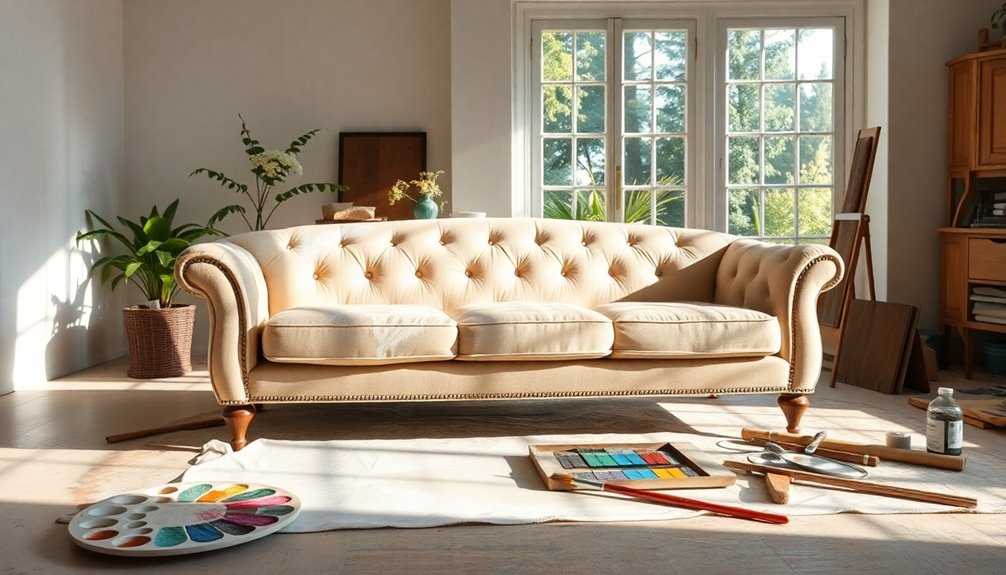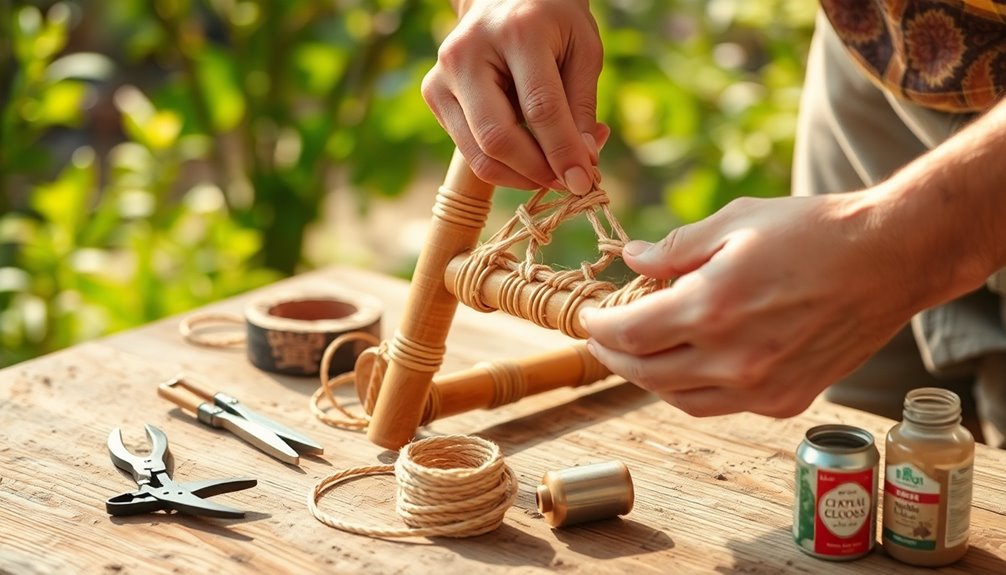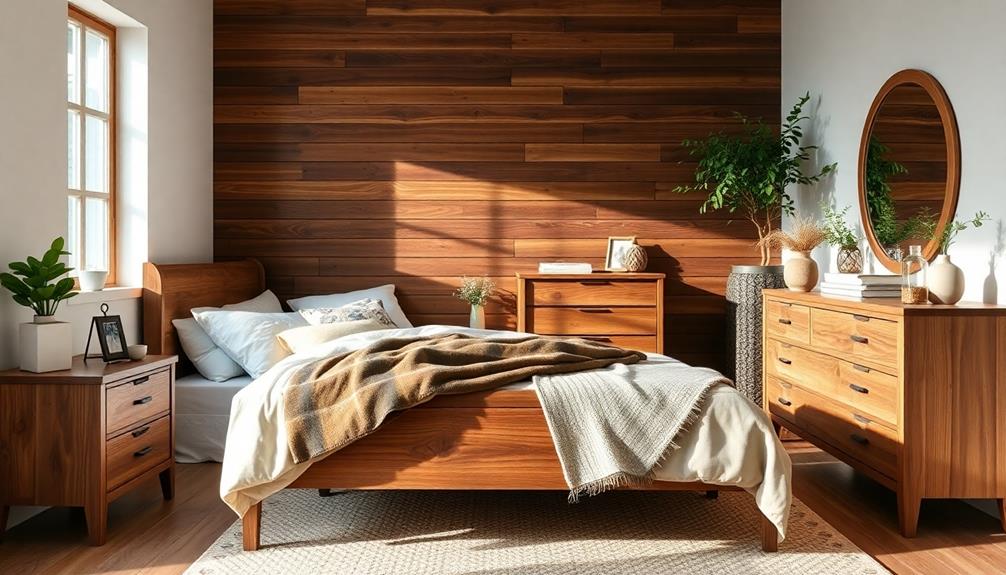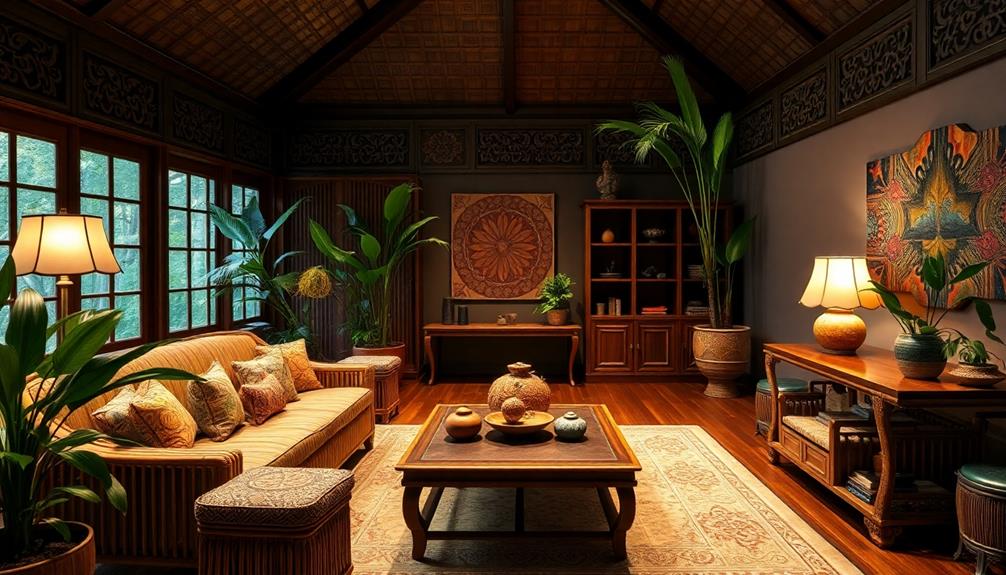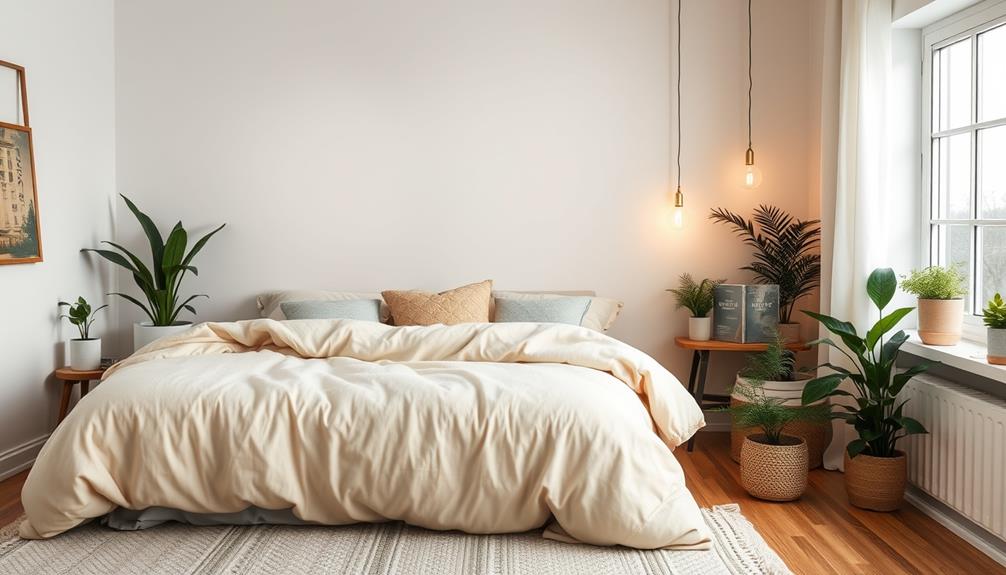To paint your sofa, start by choosing a high-quality fabric paint, like Dixie Belle, known for its vibrant colors. Lightly mist the fabric to help the paint absorb better. Use stencils or paint freehand for unique designs, testing any patterns on a small area first. Once you’re satisfied with the look, seal it using Easy Peasy Spray Wax for added protection. Make sure to vacuum the painted fabric regularly to keep it clean and fresh. With these tips in mind, you’re on your way to a beautifully refreshed sofa, and there’s even more to explore! Additionally, consider incorporating cushions or throw pillows with complementary colors and patterns to enhance the overall aesthetic of your sofa. If you’re feeling creative, learn how to sketch a simple sofa to visualize different designs and styles before committing to paint. This not only helps in planning your project but also inspires confidence in your artistic choices as you transform your living space.
Key Takeaways
- Choose high-quality fabric paint, such as Dixie Belle, for vibrant and long-lasting results on your sofa.
- Lightly mist the fabric with water before painting to enhance paint absorption and adhesion.
- Use stencils or freehand techniques to create intricate designs; practice on small areas first.
- Once painted, seal the fabric with Easy Peasy Spray Wax or water-based polyurethane for added protection.
- Regularly vacuum the painted fabric to prevent dirt accumulation and maintain its appearance.
Introduction
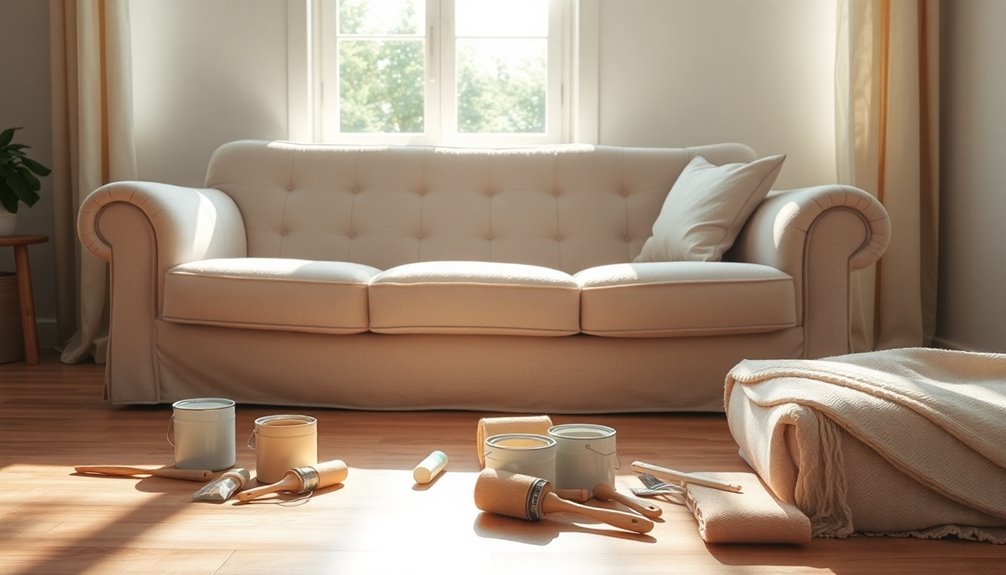
When it comes to keeping your sofa looking fresh, routine fabric care is key. You'll want to know the right cleaning techniques for different materials and have a plan for tackling stubborn stains, like red wine. By mastering these basics, you'll set the stage for a successful painting project. Additionally, maintaining a clean environment with an air purifier can help reduce allergens that may settle on your furniture, ensuring a more effective air quality improvement.
Routine Fabric Care Tips
Maintaining your painted sofa is essential for keeping it looking fresh and vibrant. Start with regular vacuuming using a soft brush attachment; this helps remove dirt and debris, preserving the appearance of painted fabric and extending its lifespan. If you experience spills, act quickly—use a damp cloth to gently blot the area. Avoid harsh rubbing, as this can damage the paint finish.
For tougher stains, you can use mild soap and water, but always test any cleaning solution on a small, inconspicuous area first to ensure it won't harm the paint. Over time, you may notice the surface feeling rough; lightly sanding the painted fabric can help maintain a smooth texture and enhance its look.
Lastly, keep leftover paint on hand for touch-ups. This allows for prompt repairs of any chips or scratches, ensuring your sofa remains well-maintained. By following these routine care tips, you'll protect your investment and enjoy your beautifully painted sofa for years to come.
Fabric-Specific Cleaning Techniques
Cleaning your painted sofa effectively requires understanding the fabric it's made from, as different materials respond to cleaning methods in various ways. Start by thoroughly vacuuming your sofa to remove loose dirt and debris. This step is crucial since any leftover particles can affect both the cleaning process and paint adhesion.
For natural fabrics like cotton and linen, mix a mild soap with water. Use this solution to gently blot stains, but be careful not to oversaturate the fabric, as excessive moisture can damage it. When you have synthetic fabrics, always test a small, hidden area first with a fabric-safe cleaner to avoid potential damage or discoloration.
If your sofa has delicate materials like velvet, opt for a soft brush or cloth. Lightly agitate the surface instead of scrubbing, as scrubbing can harm the fibers. After you've cleaned the fabric, ensure it dries completely before painting. This is vital for optimal paint absorption and helps prevent mold or mildew from developing. By understanding your sofa's fabric and applying these cleaning techniques, you'll maintain its beauty while preparing it for a fresh coat of paint. Additionally, ensure that the area surrounding the sofa is free from flammable objects to promote a safe environment during the cleaning process.
Stain Removal for Red Wine
Red wine stains can be a nightmare, but tackling them quickly makes all the difference. Start by grabbing a clean cloth or paper towel to gently blot the stain, absorbing excess wine without rubbing, which can spread the stain further. If the stain is fresh, consider sprinkling a generous amount of salt on it; this will help absorb the wine. Let it sit for several minutes before vacuuming it up.
Next, mix dish soap and hydrogen peroxide in a 1:1 ratio and apply it to the stain. Dab gently with the cloth until you see the stain lifting, then rinse the area with cold water. If you still notice remnants of the stain, don't worry. You can turn to a commercial upholstery cleaner specifically designed for different fabric types. Just follow the manufacturer's instructions for the best results.
Water-Resistant Fabric Treatments
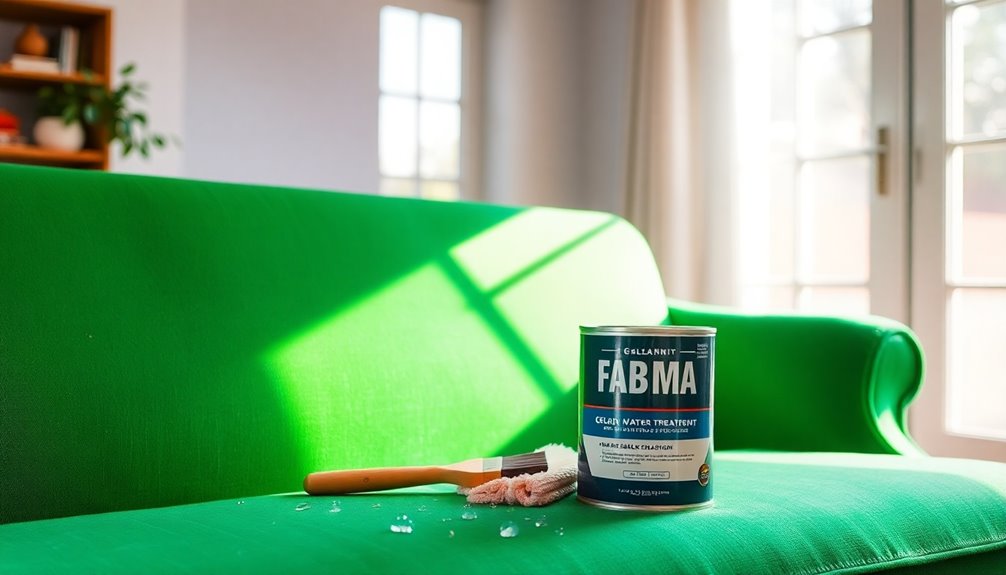
To keep your painted sofa looking fresh, consider using water-resistant fabric treatments. These options not only protect against spills but also enhance durability, ensuring your work lasts longer. You can also explore scratch-resistant fabrics, decorative blankets, and fabric protectant sprays for added defense.
Scratch-Resistant Fabric Options
When selecting a sofa fabric that can withstand the rigors of daily life, scratch-resistant options become essential, especially if you have pets or children. Opt for tightly woven materials like microfibers, which are durable and less prone to wear and tear. These fabrics not only resist scratches but also maintain their appearance over time.
It's wise to look for upholstery labeled as "performance" or "high durability." These fabrics are specifically engineered to provide enhanced resistance against scratching, making them ideal for busy households. Additionally, consider applying water-resistant treatments like Teflon or Scotchgard, which create a protective layer that repels moisture and stains, further extending the life of your upholstery.
Regular maintenance is crucial for preserving the integrity of scratch-resistant fabrics. Make it a habit to vacuum and spot clean your sofa to remove debris and prevent damage. By choosing the right materials and committing to ongoing care, you'll enjoy a beautiful, functional sofa that stands up to everyday challenges. With these considerations in mind, you'll find a fabric that not only looks great but also meets your family's needs.
Furthermore, selecting materials with high durability can contribute to the overall longevity of your furniture.
Protect With Decorative Blankets
Decorative blankets are a smart way to protect your newly painted sofa from spills and stains. By choosing blankets made from water-resistant fabrics, you can effectively extend your sofa's lifespan while maintaining its aesthetic appeal. Look for options treated with water-repellent finishes, like polyester or acrylic, which help repel moisture and prevent absorption into the fabric.
To maximize protection, make sure the decorative blankets are large enough to cover high-use areas of your sofa, such as the seating and backrest. This will help shield your paint job from wear and tear. In households with pets or children, consider layering multiple blankets to create a sturdy barrier against potential damage.
Regularly wash and maintain these blankets according to their care instructions to keep them fresh and effective at protecting your sofa's painted surface. This practice not only enhances the longevity of your protective coverings but also helps maintain the vibrant colors of your newly painted sofa. With the right decorative blankets, you can enjoy your stylish seating without the constant worry of spills and stains.
Using Fabric Protectant Sprays
Applying fabric protectant sprays is a crucial step in safeguarding your newly painted sofa from spills and stains. These water-resistant fabric treatments create a protective barrier that helps repel liquids, enhancing the durability of your painted upholstery. After allowing a 24-hour drying period for the paint, you can confidently apply a fabric protectant to maintain the sofa's appearance.
When using a fabric protectant, make sure to follow the manufacturer's instructions for optimal results. Achieve even coverage, and ensure the fabric treatments dry completely before using the sofa again. Most fabric protectants are safe for painted upholstery, so you won't have to worry about compromising the color or texture of your newly painted piece.
To keep that protective barrier effective, schedule regular reapplication every 6-12 months. This routine maintenance will help prolong the life of your painted sofa, allowing you to enjoy its beauty without the stress of potential stains. With these simple steps, your sofa will remain a stylish and functional centerpiece in your home for years to come.
Upholstery Seam Reinforcement Techniques
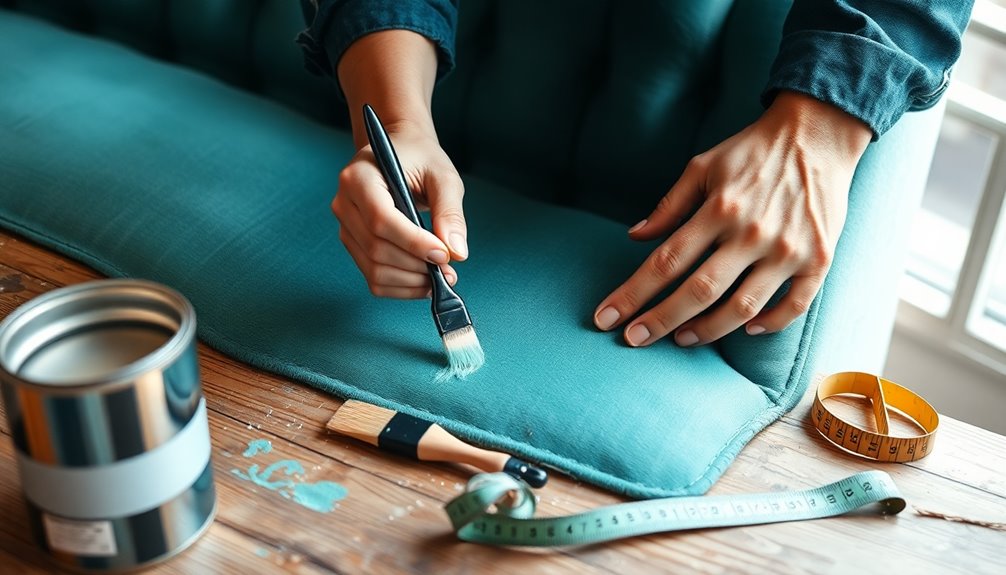
To ensure your sofa's seams hold up well, you'll want to focus on seam integrity and support techniques. Using a sewing machine with a heavy-duty thread can enhance durability, while proper upholstery repair methods will keep your fabric looking fresh. Don't forget that adding cushioning can enhance relaxation, making your newly painted sofa even more inviting.
Seam Integrity and Support
Seam integrity is crucial for maintaining the durability and longevity of your upholstered sofa. To reinforce upholstery seams effectively, consider using a strong adhesive or fabric glue to bond raw edges. This approach provides additional strength and helps prevent fraying. Additionally, employing zigzag stitching can enhance seam durability by allowing for flexibility. This technique accommodates the fabric's movement without compromising integrity.
For a quick reinforcement solution, you can use seam tape or fusible bonding web. Simply apply heat to bond the fabric layers securely, creating a lasting hold. If your sofa experiences heavy use, adding a fabric backing or interlining to the seams is a wise choice. It offers extra support, reducing strain on the main fabric.
Don't forget the importance of regular inspection. By checking seams for wear and tear, you can identify potential issues early on. This proactive approach allows for timely repairs, ultimately maintaining the overall structural integrity of your upholstery. By reinforcing seams properly, you ensure your sofa not only looks great but also stands the test of time, providing comfort and style for years to come.
Upholstery Repair Techniques
After ensuring your sofa's seams are reinforced, it's time to focus on upholstery repair techniques that can further enhance its durability. Start by using a heavy-duty sewing machine equipped with a heavy-duty needle and thread specifically designed for upholstery. This ensures your repairs are strong enough to withstand daily wear and tear.
Before sewing, consider applying seam tape or fabric adhesive to strengthen weak seams. Once you've prepared the area, use a zigzag stitch along the edges to prevent fraying and provide extra strength. This technique creates a durable barrier that holds the fabric together.
While stitching, secure the fabric layers with clips or pins. This keeps everything aligned, ensuring a clean and precise finish. Regularly inspect your upholstery seams for signs of wear. Early reinforcement can prevent further damage, extending the life of your furniture. Additionally, understanding common issues in automotive repairs can help you apply similar proactive care techniques to other areas, including furniture maintenance.
Cushioning for Enhanced Relaxation
Enhancing your sofa's comfort starts with choosing the right cushioning materials. To ensure your upholstery withstands daily use, focus on reinforcing the upholstery seams. Begin by selecting a strong, durable thread that matches your fabric. This simple choice can significantly enhance the longevity of your sofa and prevent tearing under stress.
For added strength, consider double-stitching seams, especially in high-use areas. This technique maintains the integrity of the fabric over time. When sewing, use a walking foot attachment on your sewing machine; it prevents the fabric from shifting, ensuring even stitching for a polished finish.
Before you start sewing, apply a fabric adhesive to the seam edges. This will help prevent fraying and enhance the durability of the seam, making your paint upholstery project more successful. Regularly inspect your seams for wear and perform preventative maintenance, such as re-stitching or applying additional fabric glue, to prolong the life of your upholstery.
Personalized Fabric Paint Designs
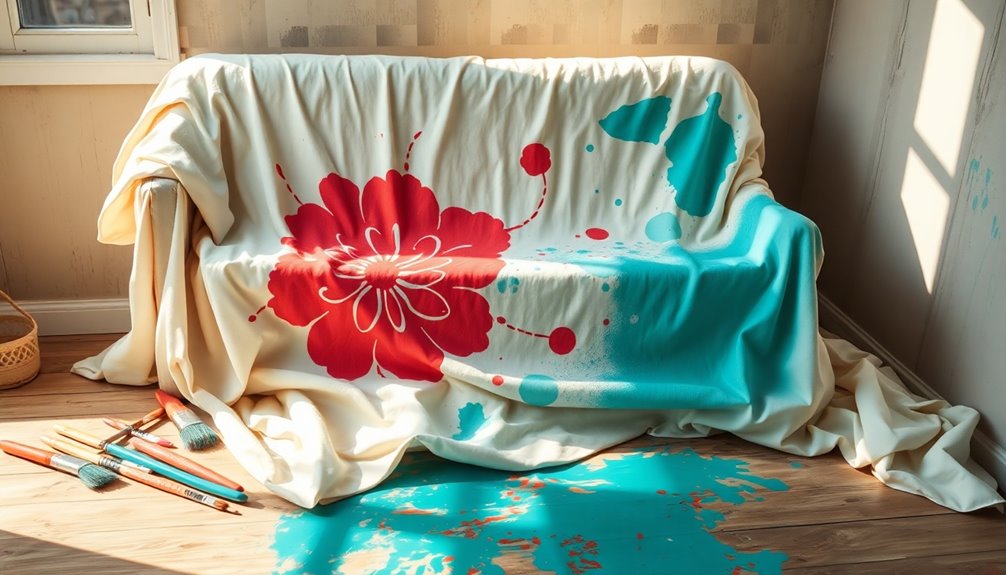
While personalizing your sofa with fabric paint designs can seem daunting, it's an exciting way to express your creativity and transform your space. Start by selecting a high-quality paint like Dixie Belle Paint, known for its vibrant, highly pigmented colors that work beautifully for painting fabric furniture. Before applying your first coat, lightly mist the fabric to open the pores, enhancing paint absorption for a smoother application.
For intricate designs, you'll want to use stencils or freehand techniques with high-quality brushes to achieve detailed effects. Always test your chosen design on a small area first to ensure you're happy with the outcome. Layering different colors can create stunning depth and dimension in your personalized designs, so don't hesitate to apply multiple thin coats for the best results.
Once you've completed your masterpiece, finish it off by sealing the design with Easy Peasy Spray Wax. This step is crucial, as it protects your artwork while maintaining the fabric's softness and enhancing durability. With these techniques, your sofa will not only look unique but also feel inviting and comfortable. Enjoy the creative process!
Fabric Longevity Maintenance Tips
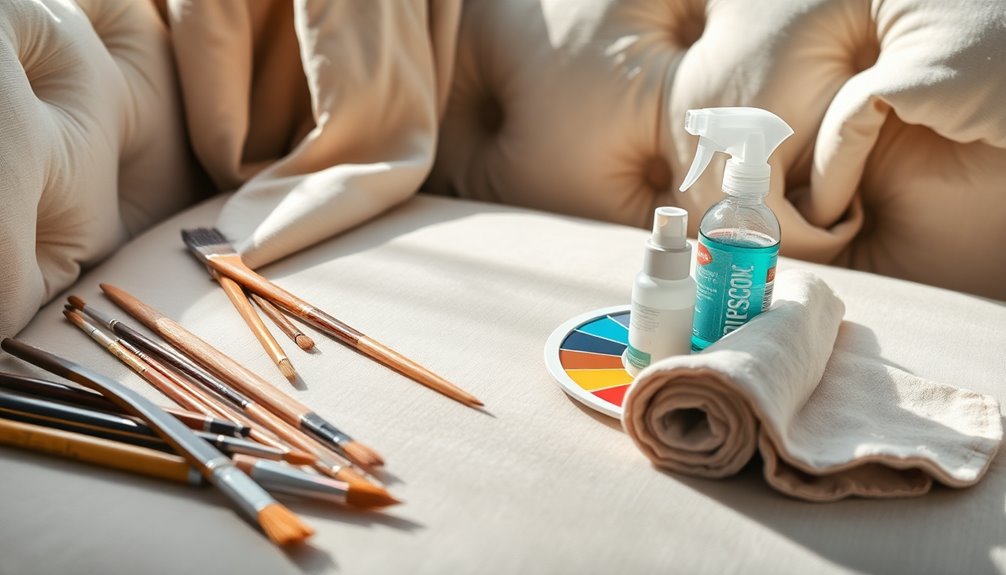
Maintaining the beauty and longevity of your painted sofa is key to enjoying your creative work for years to come. To ensure fabric longevity, start by regularly vacuuming the painted fabric with a soft brush attachment. This helps prevent dirt accumulation and keeps your sofa looking fresh. If you spill something, clean spills immediately with a damp cloth and mild soap. Avoid harsh chemicals, as they can damage the paint finish.
Inspect your sofa periodically for any signs of wear. If you notice scuffed or scratched areas, lightly sand them before repainting. When touching up, apply paint in thin layers to achieve a smooth finish. For added protection and durability, consider applying a water-based polyurethane sealant after the paint dries. Make sure to allow thorough drying between each coat to maintain appearance. Additionally, keeping your living space clean can help reduce allergens and pollutants that may settle on your sofa, improving overall indoor air quality.
Conclusion
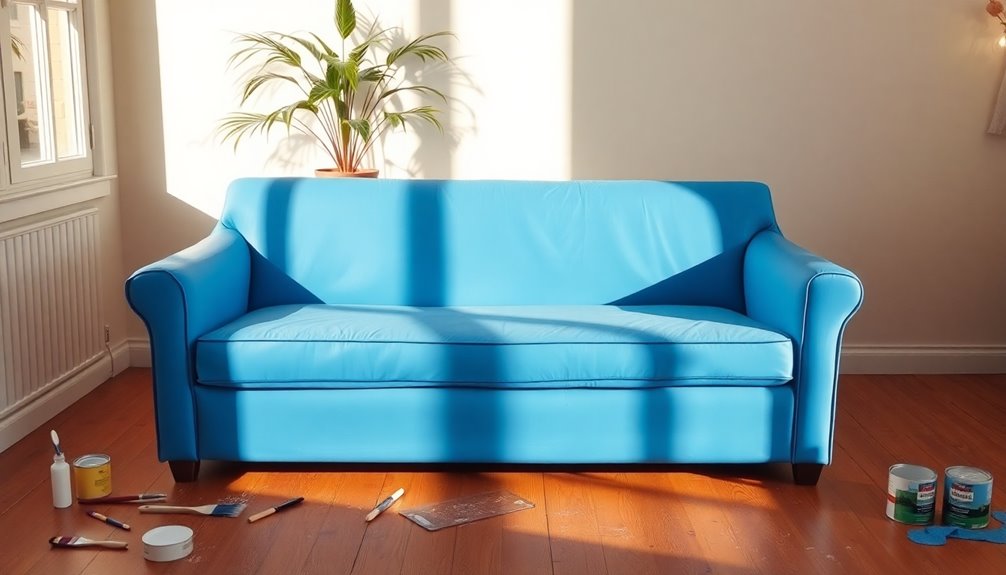
Successfully painting your sofa can transform your living space and showcase your creativity. By following the right painting techniques, you can achieve a beautiful finish that breathes new life into your furniture. Start with a specialized paint, like Dixie Belle Chalk Mineral Paint, which acts almost like a dye and requires about 50 ounces for full coverage on a standard sofa.
Prepare your fabric by lightly misting it with water to open the pores for better paint absorption. Applying two coats of paint, with light sanding between layers, will ensure a smooth finish while keeping the fabric soft and textured. Don't forget to seal your painted fabric with Easy Peasy Spray Wax after your final coat; this adds durability and protection, allowing your painted sofa to handle everyday use.
Finally, regular maintenance is key. Clean the surface with a damp cloth and promptly address any paint transfer to preserve your painted sofa's appearance. By investing time and effort into these steps, you will enjoy a stunning, customized piece that reflects your personal style for years to come. Happy painting!
Frequently Asked Questions
What Kind of Paint Do You Use to Paint a Couch?
When you're looking to paint a couch, consider using chalk mineral paint, like Dixie Belle Chalk Paint. It penetrates fabric, offering rich color without making it stiff. Mix about 3/4 water with 1/4 paint for better absorption. Always apply a fabric medium to keep the material flexible. Natural fibers like cotton and linen do best, so test a small area first to ensure the paint works well with your fabric choice.
How Do You Paint Fabric Without It Getting Stiff?
To paint fabric without it getting stiff, you'll want to mix 3/4 water with 1/4 paint for better absorption. Adding a fabric medium helps maintain softness too. Lightly mist the fabric with water before you start painting, allowing the fibers to open up. Apply multiple thin layers instead of one thick coat, and gently sand between coats to keep the texture soft. This way, you'll achieve a flexible finish without losing the fabric's feel.
How Do You Change the Color of a Fabric Sofa?
To change the color of a fabric sofa, start by cleaning the upholstery thoroughly. Next, mist the fabric with water to help the paint absorb better. Mix three parts water with one part high-quality chalk mineral paint for best results. Work in sections, allowing 2-4 hours for drying between coats. Once you're done, seal it with Easy Peasy Spray Wax for a protective finish. It's a cost-effective way to refresh your sofa!
Does Fabric Paint Last on Fabric?
Yes, fabric paint can last on fabric if you apply it correctly. When mixed with a textile medium, it bonds permanently while staying flexible. To enhance durability, mist the fabric lightly before painting and use multiple thin layers. Regular maintenance, like gentle cleaning with a damp cloth, will help preserve the paint's appearance. Many people find that with proper care, the finish remains vibrant and intact for years, ensuring long-lasting satisfaction.
